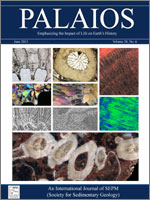Thousands of lingulid brachiopods were found clustered beneath hundreds of individual valves of the strophomenid brachiopod Rafinesquina in the Upper Ordovician of Ohio. This association suggested a relationship between the two brachiopods, but the nature of this relationship was unclear. We utilized serial thin sectioning to examine these brachiopods and to determine the origin of the bed in which they were found. Sedimentary structures, mixed taphonomies, and stratigraphic and paleogeographic setting suggest that the lingulids occupied a hiatal concentration that had previously been reworked, but not significantly transported, by tropical storms. The final burial event was a storm that exhumed living lingulids along with disarticulated Rafinesquina shells from the same sediments. Neither living nor dead shells were transported, but were reworked locally, then reburied together. The lingulids then burrowed upward to escape, but most were trapped by the concave-downward Rafinesquina shells that had been redeposited above them. This finding offers the first documented example of negative ecosystem engineering and taphonomic feedback in the fossil record, as well as the oldest documented lingulid escape traces. It also suggests that taphonomic feedback can be subdivided into live-dead interactions that occur under normal background depositional conditions and those that occur during periodic short-lived sediment-reworking events, such as storms and tsunamis.
BioOne.org will be down briefly for maintenance on 17 December 2024 between 18:00-22:00 Pacific Time US. We apologize for any inconvenience.
How to translate text using browser tools
1 June 2013
THE “CURSE OF RAFINESQUINA:” NEGATIVE TAPHONOMIC FEEDBACK EXERTED BY STROPHOMENID SHELLS ON STORM-BURIED LINGULIDS IN THE CINCINNATIAN SERIES (KATIAN, ORDOVICIAN) OF OHIO
REBECCA L. FREEMAN,
BENJAMIN F. DATTILO,
AARON MORSE,
MICHAEL BLAIR,
STEVE FELTON,
JOHN POJETA
ACCESS THE FULL ARTICLE
It is not available for individual sale.
This article is only available to subscribers.
It is not available for individual sale.
It is not available for individual sale.

PALAIOS
Vol. 28 • No. 6
June 2013
Vol. 28 • No. 6
June 2013




